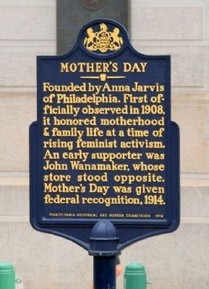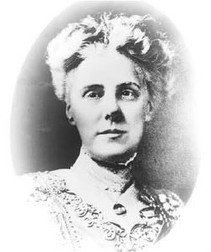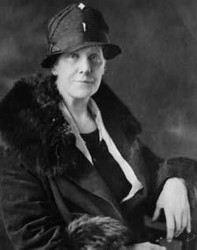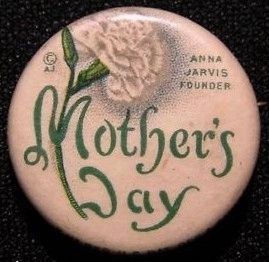Mother's Day Historical Marker
Introduction
Text-to-speech Audio
This historical marker notes that Mother's Day was first observed in the U.S. in 1908 and was signed into law through an executive measure by President Woodrow Wilson in 1914. Anna Marie Jarvis (1864 - 1948) campaigned to establish Mother's Day as a national holiday after the passing of her own mother, Anna Reeves Jarvis. Her mother was a resident of West Virginia who had, in an earlier generation, founded a "Mother's Day Work Club" in her hometown during the Civil War. Although Mother’s Day was granted federal recognition in 1914, Anna Marie Jarvis eventually grew to regret the commercialization and secularization of the holiday, as retailers sought to profit from the special occasion, and it lost its contemplative and religious connotations. In 1933, Jarvis even petitioned President Franklin D. Roosevelt to remove Mother's Day from the federal calendar. However, she could not undo what she had helped to create; the holiday remains a part of the American culture and economy to this day. This historical marker, installed by the Pennsylvania Historical and Museum Commission, describes the first observance of the holiday in the U.S. as honoring "motherhood and family life at a time of rising feminist activism." The marker also notes that an early supporter of the effort was John Wanamaker, who owned a store across the street.
Images
Mother's Day Historical Marker

Anna Jarvis

Anna Jarvis

Mother’s Day Campaign Button

John Wanamaker's Department Store (known as Grand Depot) located at 13th and Market Street, is across the street from the Mother's Day historical marker

Backstory and Context
Text-to-speech Audio
One of the first historical precedents for Mother's Day was an annual day called "Mothering Sunday," which was observed in the Christian tradition during the medieval period in Europe. Held on the fourth Sunday of Lent, it was a time when people would return to their local church or "mother church." Prior to this, there was also a precedent for Mother's Day in the ancient Greek and Roman pagan festivals that honored mothers and motherhood. Within the Greco-Roman pantheon of deities, the great mother goddess known as Rhea in ancient Greece and Cybele in ancient Rome was celebrated with an outdoor festival each April.
Although the celebration of Mothering Sunday was a part of Christian culture during the European middle ages, over time it gradually lost its religious affiliations and became more of a secular holiday in Europe (and in America). Children continued to give their mothers small gifts and flowers as tokens of their appreciation, but the historical roots of the tradition were mostly lost over the centuries. All of this changed in the nineteenth century when several women activists sought to re-establish a tradition honoring mothers during and after the Civil War. These efforts then culminated In a campaign led by Anna Marie Jarvis, a resident of Philadelphia, for federal recognition of Mother's Day in the early 1900s. Jarvis hoped that the occasion would be a time for people to remember their mothers, and to reflect and appreciate the sacrifices that they had made. In her view, this new observance of Mother's Day would be connected with the earlier contemplative and religious Christian tradition from which it emerged.
Anna Marie Jarvis's mother, Anna Reeves Jarvis, lived in West Virginia during the Civil War. During the 1860s, around the time of her daughter's birth, she founded "Mothers' Day Work Clubs" to improve childcare by promoting the teaching and sharing of mothering skills with other women in the community. The new clubs ended up providing solidarity between women in the midst of the divisive war. In 1868, Anna Reeves Jarvis decided to expand upon her Mothers' Day Work Clubs by planning a "Mother's Friendship Day," in which mothers gathered with Union and Confederate soldiers to encourage reconciliation in the years after the war.
Along similar lines but on a larger scale, in 1870 the suffragette and abolitionist Julia Ward Howe proposed a "Mother's Peace Day." Howe lived in New England and was best known for writing the lyrics to The Battle Hymn of the Republic (1861), a pro-Union anthem, at the beginning of the Civil War. Yet in 1870, five years after the war had ended, Howe penned a pacifist proclamation asking mothers to come together to promote world peace. By 1873, Howe was campaigning for this day of peace to be celebrated nationally each year on June 2nd. Around the same time, another activist named Juliet Calhoun Blakely established a local mother's day celebration in Michigan, and similar events in other communities have also been documented during this period.
In the early 1900s, Anna Marie Jarvis began campaigning in Philadelphia for Mother's Day to become an official holiday. Jarvis was moved to first observe the occasion herself after her own mother's passing in 1908, when she sent flowers to her mother's church in West Virginia. As described by the historian Katherine Antolini in Memorializing Motherhood: Anna Jarvis and the Struggle for Control of Mother's Day, Jarvis herself viewed Mother's Day as an occasion to honor the homemaking and childrearing functions of motherhood, rather than to recognize the ways in which many mothers were also engaged members of their communities with broader responsibilities outside the home. Nevertheless, a recent article in TIME Magazine notes that:
"some historians also point out the paradoxical timing of Jarvis’ version of Mother’s Day taking hold at the beginning of the 20th century: people had been talking about the idea for decades, but the holiday got national attention just at a time when more women were beginning to get jobs outside the home, and some experts see the embrace of a celebration of motherhood as a backlash against that change."
In 1912, Jarvis launched a Mother's Day International Association, and in 1914, President Woodrow Wilson signed an executive measure announcing that the special occasion would be celebrated annually on the second Sunday in May. However, the commercialization and secularization of the holiday followed soon after, much to the dismay of Anna Jarvis. She was deeply upset that Mother's Day was becoming irreverent, as florists and retailers sought ways to maximize profits from the sale of flowers and gift items. Jarvis took matters into her own hands by writing harsh letters, threatening lawsuits, planning protests, and even blaming Eleanor Roosevelt for using Mother's Day as an opportunity to raise money for charitable causes. In 1933, Jarvis went so far as to ask President Franklin D. Roosevelt to remove Mother's Day from the federal calendar. Yet, her efforts to reverse the tide were unsuccessful. The holiday that she helped to create had become part of the American culture and economy. It remains so to this day.
As a special occasion, Mother's Day is celebrated in various forms and at different times of year by other cultures across the world. In 1998, the Pennsylvania Historical and Museum Commission installed a historical marker commemorating Jarvis's particular connection to the establishment of Mother's Day in America. The marker was installed across from the former location of John Wanamaker's department store, which was known as Grand Depot, as Wanamaker had been an early supporter of Mother's Day becoming a federal holiday. The historical marker describes the origins of Mother's Day in the U.S. in the following way: "Founded by Anna Jarvis of Philadelphia. First officially observed in 1908, it honored motherhood and family life at a time of rising feminist activism. An early supporter was John Wanamaker, whose store stood opposite. Mother’s Day was given federal recognition, 1914."
Cite This Entry
Hughes, Jenevieve . "Mother's Day Historical Marker." Clio: Your Guide to History. December 18, 2022. Accessed March 25, 2025. https://theclio.com/tour/818/15
Sources
Shrewsbury, R.C. Mother's Day Historical Marker, Hmdb. November 16th, 2009. Accessed December 17th, 2022. https://www.hmdb.org/m.asp?m=24613.
Mother's Day 2022, History. April 29th, 2011. Accessed December 17th, 2022. https://www.history.com/topics/holidays/mothers-day
Orso, Anna. The Philly woman behind Mother’s Day hated what it became, Billy Penn. May 8th, 2021. Accessed December 17th, 2022. https://billypenn.com/2021/05/08/the-philly-woman-behind-mothers-day-hated-what-it-became/.
Battle Hymn of the Republic The story behind the song, Kennedy Center. Accessed December 17th, 2022. https://www.kennedy-center.org/education/resources-for-educators/classroom-resources/media-and-interactives/media/music/story-behind-the-song/the-story-behind-the-song/the-battle-hymn-of-the-republic/.
Mother's Day, Britannica. Accessed December 17th, 2022. https://www.britannica.com/topic/Mothers-Day.
Waxman, Olivia B. . The Surprisingly Sad Origins of Mother's Day, TIME. May 11th, 2017. Accessed December 17th, 2022. https://time.com/4771354/mothers-day-history-origins/.
Hmdb.org
Hmdb.org
Hmdb.org
Hmdb.org / Keith S Smith Collection
Hmdb.org

